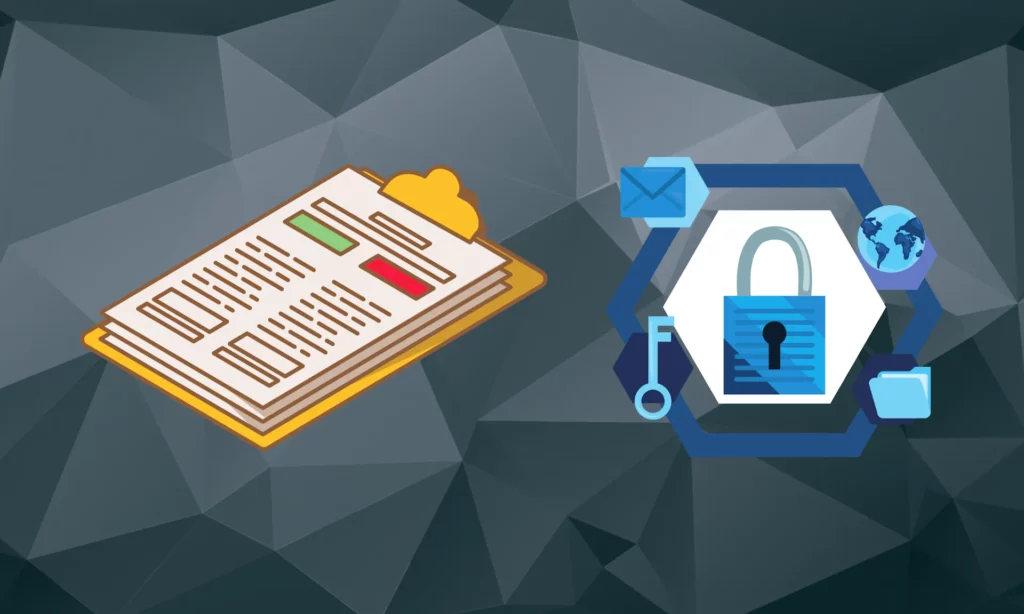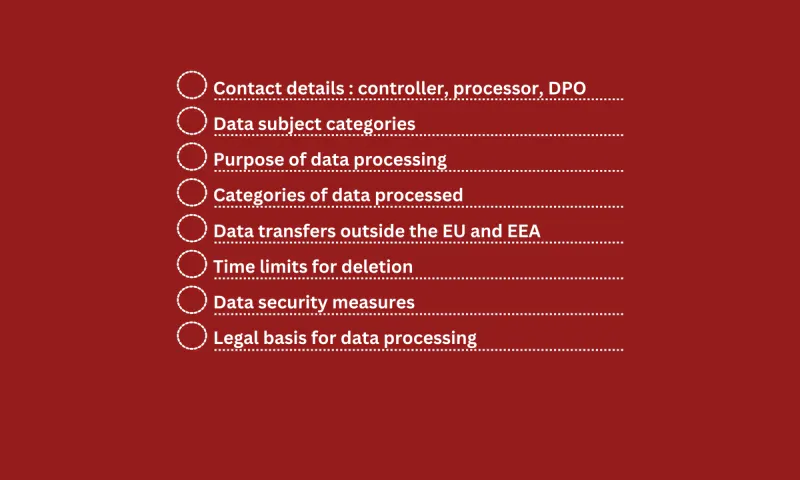
Understanding and maintaining accurate Records of Processing Activities (RoPA) is an essential part of complying with GDPR regulations.
In this article, we’ll explain what a RoPA is, why you should create one, and what it includes, and we’ll also give you some Records of Processing Activities examples from different industries to better understand this important document.
Let’s dive right in.
Key Takeaways
- A RoPA is a document or record that outlines the data-processing activities of an organization
- RoPA is mandatory for companies with 250 or more employees
- At a minimum, a RoPA includes the name and contact details of the data controller and DPO, the purpose of processing, data subject categories, who has access to the data, and the lawful basis for processing
Understanding What a Record of Processing Activities is

A Record of Processing Activities (RoPA) is a review of the data processing activities a business executes.
A RoPA is required for any business that has at least 250 employees or more. If a company has fewer than 250 employees, it is still under obligation to create a RoPA if:
- It regularly processes data and not occasionally
- Its data processing activities may be a risk to the data subject’s rights and freedoms
- Its data processing activities include sensitive personal information (SPI) or criminal conviction data.
This document doesn’t need to be overly in-depth, but it should answer the following questions:
- How is your business processing data?
- What data are you processing?
- Why are you processing data?
- Where are you processing this data?
- Who are you disclosing the data to?
Navigating the maze of data privacy regulations like the GDPR can feel daunting, but one tool stands out as a lifeline for compliance: the Record of Processing Activities (RoPA). Required under Article 30 of the GDPR, a RoPA is your organization’s roadmap to documenting how personal data flows through your operations—essential for proving accountability to regulators and avoiding hefty fines. Whether you’re a multinational with 250+ employees or a small firm processing sensitive data, a well-crafted RoPA is non-negotiable. But what does a great one look like? This guide breaks down the essentials and provides best-in-class examples from healthcare and retail to inspire your own, ensuring you’re audit-ready.
What is a Record of Processing Activities?
A Record of Processing Activities (RoPA) is a written inventory—paper or electronic—that details every instance where your organization processes personal data. Think of it as a snapshot of who, what, why, and how you handle information like names, emails, or health records. GDPR mandates this for companies with 250+ employees, or smaller ones if processing is regular, risky to rights, or involves special categories (e.g., health, biometrics). It’s not just a compliance checkbox—it’s a strategic asset for transparency and risk management.
Why You Need a RoPA
Failing to maintain an up-to-date RoPA can trigger fines up to €10 million or 2% of annual global turnover under GDPR Article 83(4). Beyond penalties, it’s your first line of defense in an audit, showing regulators you know your data landscape. Plus, it builds customer trust by proving you take privacy seriously. A robust RoPA also streamlines responses to data subject requests, like access or erasure, saving time and resources.
Core Elements of a RoPA
GDPR Article 30 spells out what a RoPA must include:
Controller/Processor Details: Name and contact info of the organization and Data Protection Officer (DPO), if applicable.
Purpose of Processing: Why you’re handling the data (e.g., payroll, marketing).
Data Subjects: Who’s affected (e.g., employees, customers).
Data Categories: What’s collected (e.g., names, addresses, payment details).
Recipients: Who gets the data (e.g., third-party vendors, regulators).
Transfers: Cross-border data flows and safeguards (e.g., EU-US Data Privacy Framework).
Retention Periods: How long data is kept.
Security Measures: How it’s protected (e.g., encryption, access controls).
Processors have a slightly simpler list, focusing on categories of processing and security measures, but the principle is the same: clarity and accountability.
Best Practices for Crafting a RoPA
Before diving into examples, here’s how to make yours shine:
Start with Discovery: Map your data flows—engage HR, IT, marketing, and legal teams to catch everything.
Keep It Granular: Break processing into specific activities (e.g., “employee payroll” vs. “HR management”).
Update Regularly: Review quarterly or after major changes (new software, vendors).
Use Software: Tools like Captain Compliance or OneTrust automate updates and audits.
Stay Audit-Ready: Ensure it’s concise yet comprehensive for regulators.
Now, let’s explore two standout RoPA examples from different industries.
Example 1: Healthcare Provider RoPA
Overview
A mid-sized healthcare clinic in New York, with 300 employees, processes sensitive patient data daily. Here’s how they document one key activity under GDPR and CCPA.
RoPA Entry: Patient Appointment Scheduling
Controller: HealthFirst Clinic, 123 Main St, New York, NY 10001; DPO: Jane Doe, jane.doe@healthfirst.com
Purpose: Scheduling and managing patient appointments for medical consultations.
Data Subjects: Patients seeking healthcare services.
Data Categories: Name, phone number, email, appointment date/time, medical condition (if provided).
Recipients: Internal staff (receptionists, doctors); third-party scheduling software (e.g., Acuity Scheduling).
Transfers: Data hosted on U.S.-based servers; no international transfers unless patient consents to telehealth with overseas specialists (safeguarded by standard contractual clauses).
Retention: 7 years post-last appointment, per HIPAA and state law.
Security Measures**: End-to-end encryption, two-factor authentication, annual staff training.
Why It’s a Great Example
This RoPA is precise, tying each element to a legal basis (patient consent or healthcare provision under GDPR Article 6(1)(b)). It addresses sensitive health data—a special category under GDPR Article 9—while aligning with U.S. retention laws, showing dual compliance. The security details reassure regulators of robust protection, critical in healthcare.
Example 2: E-Commerce Retailer RoPA
Overview
A UK-based online retailer with 150 employees processes customer data regularly, triggering GDPR’s RoPA requirement despite its size. Here’s their entry for marketing.
RoPA Entry: Email Marketing Campaigns
Controller: ShopSmart Ltd, 45 High St, London, UK EC1A 1AA; DPO: Tom Smith, tom.smith@shopsmart.co.uk
Purpose: Sending promotional emails to boost sales and customer engagement.
Data Subjects: Registered customers and newsletter subscribers.
Data Categories: Name, email address, purchase history, browsing behavior (via cookies, with consent).
Recipients: Internal marketing team; third-party email platform (e.g., Mailchimp, based in the U.S.).
Transfers: Data transferred to U.S. servers under the EU-US Data Privacy Framework; adequacy confirmed.
Retention: 2 years post-last interaction or until consent is withdrawn.
Security Measures: Encrypted databases, access restricted to marketing staff, regular penetration testing.
Why It’s a Great Example
This entry excels by specifying consent as the legal basis (GDPR Article 6(1)(a)), critical for marketing data. It addresses cross-border transfers—a common e-commerce challenge—with clear safeguards, and its retention period reflects proportionality. The security measures are practical yet thorough, tailored to a digital-first business.
Industry Variations: Tailoring Your RoPA
Healthcare
Focus on special categories (health data), strict retention (e.g., 7-10 years), and HIPAA/GDPR overlap if U.S.-based. Highlight patient consent and third-party processors like labs.
Retail/E-Commerce
Emphasize customer consent for marketing, cookie tracking, and international transfers (e.g., payment processors). Keep retention short unless legally required.
HR/Employee Data
Detail employee records (payroll, performance), legal basis (contract fulfillment), and internal sharing (e.g., benefits providers). Retention often ties to employment laws (5-7 years).
Common Pitfalls to Avoid
Vagueness: “Customer management” is too broad—specify “order fulfillment” or “support tickets.”
Outdated Records: A static RoPA fails audits—schedule reviews.
Missing Details: Skipping recipients or security measures invites scrutiny.
Overcomplicating: Keep it readable—regulators hate clutter.
Tools to Build Your RoPA
Excel works for small firms, but scaling up calls for software. Captain Compliance offers templates and automation, integrating with data systems to track changes. OneTrust and DataGuard provide similar solutions, with dashboards for real-time updates. Pick one that fits your size and budget—automation saves hours and reduces errors.
Why Should You Create a RoPA?
Through the RoPA, your business demonstrates its compliance with the supervisory authority.
In particular, businesses can demonstrate that they can implement the principle of accountability of the GDPR and that they understand the implications of processing personal data.
It’s important to note that a RoPA is not the same as a Data Privacy Assessment (DPIA) and that this is a standalone document. This means that the supervisory authority should not be expected to review several documents for a RoPA.
What Information Should be Included in a RoPA?

Article 30 and Article 6 of the GDPR outline what information is mandatory to include in a RoPA. This information has to be in writing or electronic form and must be made available at the request of the supervisory authority.
The information that a data controller and processor must include in a RoPA are:
- Name and contact details of the controller, processor, and the data protection officer
- Data subjects that the processed data relates to
- Purpose of data processing
- Categories of data processed
- Information regarding data transfers outside the EU and EEA
- Time limits for deletion
- Data security measures (see Article 32(1))
- Legal basis for data processing (see Article 6 of GDPR)
In addition, the business can include the following information, though this is not mandatory by the GDPR:
- What IT systems were used to process this data
- Use of data processors
- Are there special categories (SPI)
- A further description of the data processing
- Any works council agreements that regulate data processing
Legally Required Minimum RoPA Example
The legally required minimum of information that a RoPA should include and needs to be made available to the supervisory authority per its request is again outlined in Article 30 of the GDPR.
Here is a minimum required Records of Processing Activities example:
- Name and contact details of the data controller: Company, address, postal code, phone number, email address
- Name and contact details of the DPO: Outsourced DPO company, email
- Purposes of processing data: i.e., payroll administration, promotional emails, etc.
- Description of the data subjects categories: For example, permanent company staff
- Who the data have or will be disclosed to: For instance, bank, legal advisor, etc.
- Categories of recipients in other countries or organizations that the data is or will be disclosed to
- The name of the country/international organization
- Lawful basis: For example, Article 6(1)(b)
Records of Processing Activities Example for Different Industries
Next, we’ll show two Records of Processing Activities examples for different industries, financial services, and healthcare.
RoPA Example 1 Below: Financial Service Company
RoPA Example 2 Below: Healthcare Service Company
Importance of Updating a RoPA
As you can see from these two Records of Processing Activities examples, the information in RoPA is often subject to change. This means that a RoPA is a “living” document and needs to be kept up-to-date.
This includes:
- Regularly reviewing and updating the RoPA document
- Keeping the RoPA in an electronic form rather than paper (as it is easier to update and save)
- Removing the processing activities that are no longer taking place from the RoPA
- Educating employees on the importance of adding new products or services that require processing to the RoPA
Closing
Understanding and maintaining a Records of Processing Activities (RoPA) is vital for companies to comply with GDPR regulations.
This crucial document oversees the data-processing activities within your organization – from collecting personal client information to processing it. It helps identify vulnerabilities that, if not managed properly, could lead to legal problems.
What else do you need to demonstrate your GDPR compliance? Find out by contacting our compliance and data privacy experts at Captain Compliance, and we’ll make sure you have everything covered!
FAQs
What are the Records of Processing Activities for GDPR?
A Record of Processing Activities (RoPA) is a document that shows the data processing activities of the company along with other relevant information.
This document serves to showcase the company’s accountability and commitment to uphold the best practices when it comes to data processing activities.
Confused about records of processing activities? Get in touch with us to find out more!
What are Examples of Processing Activities?
Data processing activities include everything from gathering data, storing, organizing, analyzing to erasing.
Some processing activities include:
- Data cleaning and preprocessing
- Data analysis
- Data storage and retrieval
- Data erasure
Here is our article on data deletion under the CPRA.
Is My Business Required to Do a RoPA?
If your organization is regularly conducting data processing activities, under the General Data Protection Regulation (GDPR), it is obligated to create and maintain a Record of Processing Activities or RoPA.
This is our complete GDPR compliance checklist that you need if you want to comply with the GDPR.
What are the 10 Data Processing Activities?
Data processing includes several activities or steps, including:
- Data collection: Gathering data from different sources such as databases, online forms, etc.
- Data preparation: Ensuring data quality by detecting and correcting errors
- Data transformation: Reorganizing the data in a different format (better suited for analysis or sharing)
- Data aggregation: Creating a summary of data from different sources
- Data analysis: Using different techniques (machine learning, data mining, statistics) to analyze data
- Data visualization: Graphically representing data (charts, tables, graphs…)
- Data storage: Storing the data in secure storage systems or databases for easier access
- Data retrieval: Accessing stored data from storage systems
- Data reporting: Creating reports and analyzing summaries for stakeholders and decision-makers
- Data backup and archiving: Storing and archiving historical data for regulatory compliance